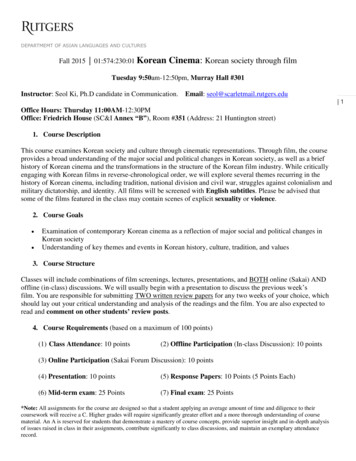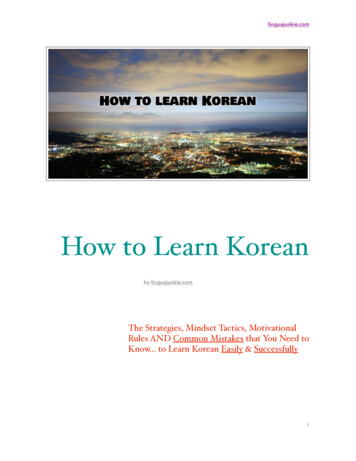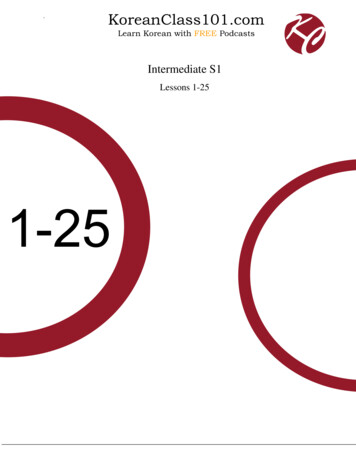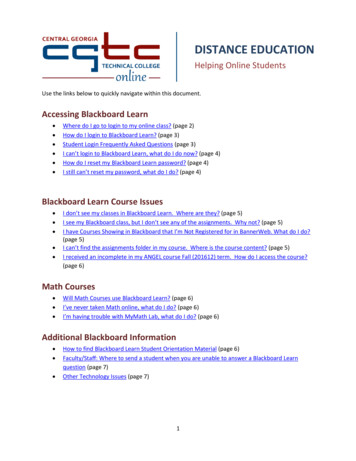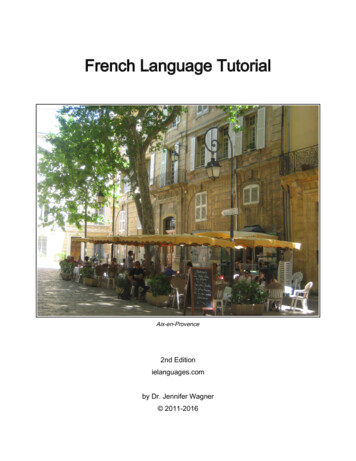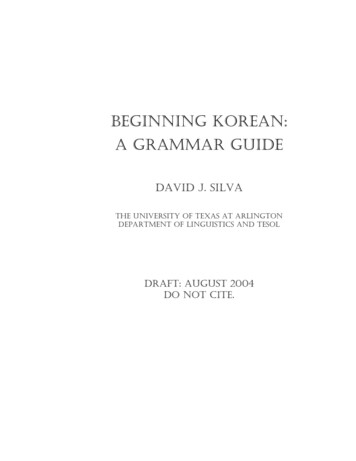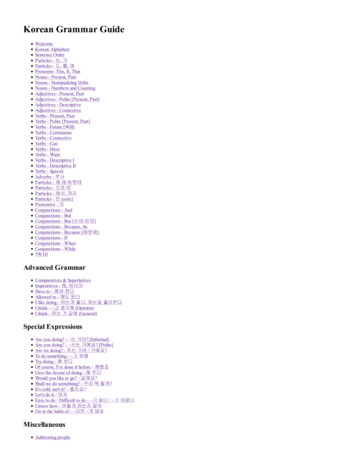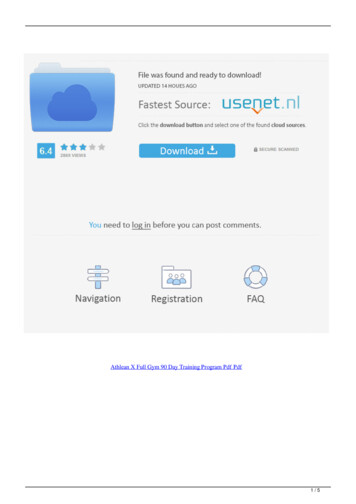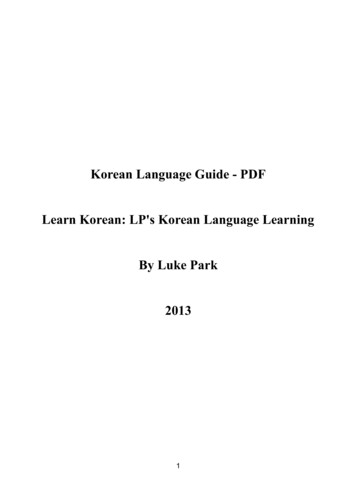
Transcription
Korean Language Guide - PDFLearn Korean: LP's Korean Language LearningBy Luke Park20131
Korean Language GuideThe following are the complete list of the lessons created so far in this Korean Language Guide. Welcome Korean Alphabet Sentence OrderParticles Topic Particle - 는 / 은 Identifier Particle - 가 / 이 Subject Particles - 는 / 은 and 가 / 이 Additive Particle - 도 Object Particle - 를 / 을 Time / Place Particle - 에Pronouns Pronouns (I, You) - 나, 저, 너, 당신 Pronouns (He, She) - 그, 그녀, 걔, 그분 Pronouns (He, She) - 얘, 쟤, 걔 Pronouns (They) - 그들, 걔들, 그분들 Pronouns- This, It, ThatNouns Nouns - Present, Past Nouns - Nominalising Nouns - Nominalizing Verbs Nouns - Numbers and CountingAdjectives Adjectives - Present, Past Adjectives - Polite [Present, Past] Adjectives - Descriptive Adjectives - ConnectiveVerbs Verbs - Present, Past Verbs - Polite [Present, Past] Verbs - Future [Will] Verbs - Continuous Verbs - Connective Verbs - Can Verbs - Have Verbs - Want2
Verbs - Descriptive I Verbs - Descriptive II Verbs - SpeechAdverbs Adverbs - 부사Particles Particles - 께/에게/한테 Particles - 으로/로 Particles - 에서, 까지 Particles - 만 [only]Possessive Possessive - 의Conjunctions Conjunctions - And Conjunctions - But [ 지만] Conjunctions - But [는데/은데] Conjunctions - Because, So [ 서] Conjunctions - Because [때문에] Conjunctions - If/Once [ 면] Conjunctions - If/Once [ 거든] Conjunctions - When [ 때] Conjunctions - While [ 며/면서] 5W1HAdvanced Grammar Comparatives & Superlatives Imperatives - 해, 하지마 Have to - 해야 한다 Allowed to - 해도 된다 I like doing - 하는게 좋다, 하는걸 좋아한다 I think - 고 생각해 (Opinion) I think / It seems - 하는 거 같애 (General) I used to do - 했었어 I used to do - 하던 (I learned that) 더라고 (I found that) - 던데 I heard / You said - 며3
There is / I have - 있다/있네Special Expressions Are you doing? - 는 거야? [Informal] Are you doing? - 시는 거예요? [Polite] Are we doing? - 하는 거야 / 거예요? Go to do - 러 가다 To do something - 기 위해 Try doing - 해 보다 Of course, I've done it before - 해봤죠 Give the favour of doing - 해 주다 Would you like to go? - 갈래요? Shall we do something? - 우리 뭐 할까? It's cold, isn't it? - 춥지요? Let's do it - 하자 Easy to do / Difficult to do - 기 쉽다 / 기 어렵다 I know how - 어떻게 하는지 알아 I'm in the habit of - 되면 게 돼요 Because I'm - 거든요 I will go first - 먼저 갈게Phrases As I was doing - 하다 보니깐Other Lessons Addressing people Pronunciation4
Learning the Korean Language for the First Time!Please refer to Audio Recordings - Introduction, to learn about "WHY" listening to Korean is soimportant in learning Korean.Welcome You All to the Korean Language Guide!This blog was first created in 2006 as an experiment to help people who would like to learn Koreanlanguage online by providing some basic grammar lessons on Korean.Over the years, I was able to put up more and more Korean language lessons online, and as of now,in January 2011, there are more than 70 online Korean lessons in this blog.The principles in writing these online Korean language lessons have been that I remain intentionalabout making them as easy to understand and readily applicable in daily life as I can, andcomprehensive enough to cover major points of the Korean language which includes boththe Written and Spoken forms.Now, what do I mean by written and spoken forms?In Korean, the verb endings change depending on whether the language is used in writing or speech.Note: In Korean grammar, the verbs come at the end of a sentence. For more on the sentence order,please read Sentence Order.For example, "나는 학교에 갔다" which means "I went to school" is a written form, and "나는 학교에 갔어" is a spoken form. 나는 학교에 갔다 I went to school (written form as in writing, books, diary andnewspaper) 나는 학교에 갔어 I went to school (spoken form as in conversations, movies anddramas)As you can see, the ending of a verb changes from 갔다 to 갔어, both of which mean "went".Therefore you'd write in one way but speak in a slightly different way. But don't be too alarmed atthe difference, as there are simple patterns to it, and you'll get to learn them along the way.It is also important to learn the differences in degrees of formalities in the Korean language.There are three major types in the degrees of formality: Informal Polite HonorificIn expressing the politeness in the speech, Korean differs from English in that the verb endingschange depending on the age and rank of the person being addressed to and the social setting onefinds oneself in. For example, when I'm asked, "Where are you going?" I might answer, "I'm goingto school" in the following ways:5
학교 가 - [Informal, to people of the same age as me or younger than me, especially amongclose friends] 학교 가요 - [Polite, to people older than me, and in formal social situations] 학교 가는 중입니다 - [Honorific, this is rarely used in normal conversations. I would saythis type of speaking is only found in very formal settings such as on the news or in thearmy.]You would use the polite form even when the person you're speaking to is of the same age as you oryounger than you if you're not very close to the person and/or you're in a formal social setting. I'dsay it's best to stick to the polite form first and then use the informal form later as you gain moreunderstanding of the Korean language.The major mark of the division is probably the age. The polite language is used to people aboveone's age and informal language to people equal to and below one's age.However, generally, the polite language is generally used in many social situations and the informallanguage is usually used among close friends.I am trying to lay out some basics to the language of Korean. However it'd be good at this point todive into the lessons and learn them for yourself.You can start reading the Korean language guide on this website, Learn Korean: LP's KoreanLanguage Learning, from the top to bottom in the order as it's designed to guide you from the basicsto intermediate and advanced Korean lessons.Before you go, here is a bit of history of 한글 (Hangeul, the Korean alphabet):Korean is the official language of Korea, both North and South. There are around 78 million peoplewho speak Korean around the world. [1]한글 (the Korean alphabet) was invented by Sejong the Great in the 15th century. Before that time,people used Hanja (the equivalent of the Chinese characters) which was not only difficult to learnbut was also considerably different to the Korean grammar and sentence order. [2]한글 is a phonetic writing system which means that the words correspond to pronunciation.The English alphabet is phonetic whereas the Chinese characters are not.If you learn the English alphabet, you can read an English writing fairly well although you may notunderstand the meaning.Korean is even more phonetic than that of English and many other languages, in that eachconsonant and vowel in Korean mostly have only one sound.For example, ㄴ n ㅏ a (as in car and mama, short sound)ㄴ ㅏ 나 [na] (which means "I" as in "I" am Luke)6
Following the guide for the Korean language down the column on the right-hand of the page, we'renow moving onto learning the sounds of the consonants and vowels of 한글.You'll learn to write and pronounce each of these consonants and vowels, and how to form acharacter in this next lesson.Keep on reading!I hope you enjoy this journey of learning a new language!I think it's always exciting to learn a new language! ;DLukeReferences[1] Wikipedia: Korean language, http://en.wikipedia.org/wiki/Korean language#History, accessedJan 2011.[2] Wikipedia: Sejong the Great, http://en.wikipedia.org/wiki/Sejong the Great#Hangul, accessedJan 2011.7
The Korean AlphabetLearning Korean for the first time!Hangeul or 한글 (the Korean alphabet) literally means "the Korean writing."In 한글, the Korean alphabet, consists of 14 consonants and 10 vowels. Cosonants: ㄱㄴㄷㄹㅁㅂㅅㅇㅈㅊㅋㅌㅍㅎ Vowels: ㅏㅑㅓㅕㅗㅛㅜㅠㅡㅣIn addition, there are 5 double consonants and 11 double vowels. Double consonants: ㄲㄸㅃㅆㅉ Double vowels: ㅐㅒㅔㅖㅘㅙㅚㅝㅞㅟㅢAdditionally, there are 11 final double consonants. Final double consonants: ㄳ ㄵ ㄶ ㄺ ㄻ ㄼ ㄽ ㄾ ㄿ ㅀ ㅄPlease also refer to the audio recording of different Korean consonant-vowel combinations that Iproduced with my own voice, here, Korean alphabet - Consonants and Vowels.You will get to learn these basic consonants and vowels, learning how to read, write and pronounce.Click on the alphabet to listen to their corresponding pronunciations.(Provided by Korean language learning online, Sogang Unversity)자음[Consonants]ㄱ gㄴ nㄷ dㄹ l, r (ㄹ is a sound somewhere between l and r)ㅁ mㅂ bㅅ sㅇ "no sound" when used as a first consonant, "ng" when used as a final consonant.ㅈ jㅊ chㅋ kㅌ tㅍ pㅎ h모음[Vowels]ㅏ aㅑ yaㅓ eo8
ㅕ yeoㅗ oㅛ yoㅜ uㅠ yuㅡ euㅣ i쌍자음[Double consonants]ㄲ gg Click on the link to hear the difference between the sounds of ㄱ, ㄲ and ㅋ.ㄸ dd Note the difference in sounds; ㄷ, ㄸ and ㅌ.ㅃ bb Note the difference in sounds;ㅂ, ㅃ and ㅍ.ㅆ ss Note the difference in sounds; ㅅ and ㅆㅉ jj Note the difference in sounds; ㅈ, ㅉ and ㅊMore links: ㄲ, ㄸ, ㅃ, ㅆ, ㅉ쌍모음[Double Vowels]ㅐ aeㅒ yae (rarely used)ㅔ eㅖ yeㅘ waㅙ waeㅚ oeㅝ woㅞ we (rarely used)ㅟ wiㅢ ui How to form a characterThere are two ways of making a character, using the consonants and vowels as building blocks.1.Initial consonant Vowel2.Initial consonant Vowel Final consonant1. Examples 가 ㄱ ㅏ ga 너 ㄴ ㅓ neo 도 ㄷ ㅗ do 루 ㄹ ㅜ lu/ru 므 ㅁ ㅡ meu 비 ㅂ ㅣ bi2. Examples 각 ㄱ ㅏ ㄱ gag 넌 ㄴ ㅓ ㄴ neon 돗 ㄷ ㅗ ㅅ dod9
를 ㄹ ㅡ ㄹ leul/reul 쟁 ㅈ ㅐ ㅇ jaengCharacters with final consonants of ㄱ, ㄲ and ㅋ, all sound the same. Thus 각, 갂 and 갘 willsound exactly the same.For example,국, 엌, 밖 Their final consonants all sound the same. Click on the links to hear.Now, below is a list of the final consonants and their respective sounds. ㄱ/ㄲ/ㅋ ㄱ ㅂ/ㅃ/ㅍ ㅂ ㄷ/ㅌ/ㅅ/ㅆ/ㅈ/ㅊ/ㅎ ㄷ ㄴ ㄴ ㄹ ㄹ ㅁ ㅁ ㅇ ㅇFor example, 낚시 [낙시] fishing 부엌 [부억] kitchen 앞 [압] front 씨앗 [씨앋] seed 낮 [낟] dayFor a more detailed explanation and audio files, click here.When the initial consonant of second and/or third characters is ㅇ, for example, 돌이 and 만악이,the sound of the final consonant of each letter is pronounced with the next vowel. Because ㅇ hasno sound, 돌이 is pronounced as 도리 and 만악이 as 마나기. These are just made-up words to showyou how these work. 돌이[도리] 만악이[마나기]For more examples on this pronunciation, click on the link.쌍받침[Final double consonants]There are also 11 additional final double consonants. Their sounds are as follows. As you can see,the first consonant of the double consonants is pronounced. (except ㄺ ㄱ,ㄻ ㅁ and ㄿ ㅂ) Ido not recommend that you learn these exhaustively right away because that is a hard work and Irarely employed them in my grammar lessons anyway. So it would be better to come back to thesewhen you come across them from time to time. ㄳ ㄱ ㄵ ㄴ ㄶ ㄴ ㄺ ㄱ10
ㄻ ㅁ ㄼ ㄹ ㄽ ㄹ ㄾ ㄹ ㄿ ㅂ ㅀ ㄹ ㅄ ㅂEg.삯 [삭] amount앉다 [안따] sit많다 [만타] many읽다 [익따] read삶다 [삼따] boil넓다 [널따] spacious외곬 [외골] a single way핥다 [할따] lick읊다 [읍따] recite (a poem)잃다 [일타] lose (a thing)값 [갑] priceExcellent pronunciation lessons by Sogang Unversity (Korean language learning online)Source: http://korean.sogang.ac.kr/Also, check out the Korean Wiki Project for additional explanations of the Korean consonants andvowels and respective pronunciations.For writing practices, Consonants Vowels Consonants VowelsSources:Slow but STEADY: http://cyjn.com/165키드앤틴, KidnTeen: http://www.kidnteen.com/hannnum/han.asp11
Sentence OrderPlease refer to Audio Recordings - Sentence Order, to listen to the sentences used in this lesson.In regards to the order of a sentence, there are four basic types in Korean. These are: S N S V S A S O V* S subject, N noun, A adjective, O object and V verb.The tense of a sentence is determined by the last part of a sentence, namely, by a noun, verb oradjective.In Korean, adjectives function like verbs in that they can be converted to different forms todetermine the tense of a sentence.For example, In English, the past tense of "go" is "went." In Korean, the past tense of "가다" (gada, go) is "갔다" (gatta, went).The verbs function in the same way in English and Korean.However, in the case of adjectives, the past tense of "good" in English is not "gooded" but it iswritten, "was good."Contrary to this, in Korean, "좋다" (jota, good) has a past tense form of "좋았다" (joatta, wasgood).Compare: In English, "good" (present) "was good" (past) In Korean, "좋다" (present) "좋았다" (past)Therefore, the adjectives in Korean function like verbs in that they can be converted to a past tenseor future tense, or any other tense forms.This conversion of a verb(or adjective) to its past, future, present continuous or past continuoustense forms is called a verb (or adjective) "conjugation."Before proceeding to the explanation section below, I recommend that you readthe "particles" alongside this post.To understand Korean grammar, it is crucial that you become familiar with the concept of a distinctpart of speech called, "particles."Particles are function words that indicate what the subject or object is in a sentence.12
For example, 는/은 is a topic particle 가/이 is a identifier particle 를/을 is an object particleFor more information and explanation on particles, please refer to (Particles - 는, 도, 를, 가, 에).Now, let's have a look at the four main types of Korean sentences.Note: S Subject, N Noun, V Verb, A Adjective, O Object1. S N 나는 학생이다 I am a student 리사는 선생님이다 Lisa is a teacher 앤드류는 의사였다 Andrew was a doctor 저는 중학생이에요 I am a middle school student [polite spoken form]For more explanations on the S N pattern, please read Nouns - Present, Past.나 I학생 student리사 Lisa선생님 teacher앤드류 Andrew의사 doctor저 I (polite)중학생 a middle school student2. S V 주영은 달린다 Ju-young runs [written form] 주영은 달려요 Ju-young runs [polite spoken form] 주영은 힘차게 달린다 Ju-young vigorously runs*An adverb comes before a verb.주영 Ju-Young (a Korean male name)달리다 run달려 run [spoken form]달려요 run [polite spoken form]힘차게 vigorouslyFor more information and explanations on verbs, please read Verbs - Present, Past and Verbs Polite [Present, Past].3. S A 그는 크다 He is big13
그녀는 작다 She is small 앤은 예쁘다 Anne is pretty [written form] 앤은 정말 예뻐요 Anne is really pretty [polite spoken form] 산이 아름답다 The mountain is beautiful 날씨가 정말 좋다 The weather is very good그 he크다 big그녀 she작다 small앤 Anne정말 really, very예쁘다 pretty산 mountain아름답다 beautiful날씨 weather좋다 goodFor more information and explanations on adjectives, please read, Adjectives - Present,Past, Adjectives - Polite [Present, Past] and Adjectives - Connective.4. S O V 나는 사과를 먹었다 I ate an apple. 지성은 물을 마신다 Ji-sung drinks water. 새들이 노래를 부른다 The birds are singing songs. 안나는 대학을 다닌다 Anna attends college (university) [written form] 안나는 대학을 다녀요 Anna attends college (university) [spoken form] 영희는 어제 정원에 꽃을 심었다 Young-hee planted a flower in the garden yesterday.*Notice that the time(어젯밤) and place(정원에) are inserted between S and O.나 I사과 apple먹었다 ate물 water마시다 drink새 a bird새들 birds노래 song부르다 sing다니다 attend [written form]다녀요 attend [polite spoken form]어제 yesterday정원 garden꽃 flower심다 plant (verb)14
In addition, unlike English, it is quite common to leave out the subject in a sentence in Korean.When the subject is known by the readers or speakers, it is often left out. Therefore, depending on asituation or context, it is OK to write or speak without beginning the sentence with a subject.A subject may not be used in a sentence if it is known who or what the subject is. So, the sentencesbelow are also correct and it is common in spoken Korean (conversations). 학생이다 (am/is) a student 선생님이다 (am/is) a teacher 의사였다 was a doctor 중학생이에요 (am/is) a middle school student 달린다 runs 힘차게 달렸다 vigorously ran 크다 (am/is/are) big 작다 (am/is/are) small 정말 좋아 (am/is/are) really good [spoken form] 사과를 먹었다 ate an apple 물을 마셨어 drank water [spoken form] 노래를 불렀어 sang songs [spoken form] 어제 꽃을 심었어요 planted a flower yesterday [polite spoken form]For more help with the particles, please refer to the following posts: Particles - 께/에게/한테 Particles - 으로/로 Particles - 에서, 까지 Particles - 만 [only] Possessive - 의15
Learn Korean Language: ParticlesParticles are functional words that do not have any meaning in themselves.They are like helpers in that they are attached to the end of nouns to indicate what that noun is andhow it functions in a sentence.The following links show the list of most common particles used in Korean language. Particles - 는 / 은 Particles - 가 / 이 Subject Particles Particles - 도 Particles - 를 / 을 Particles - 에16
Topic Particle - 는 / 은Please refer to Korean Listening Exercise - Topic Particle 는/은 for the audio recording of thesentences found in this lesson.Particles are functional words that do not have any meaning in themselves.They are like helpers in that they are attached to the end of nouns to indicate what that noun is andhow it functions in a sentence.This particles section is divided into several parts.These are: 는/은 - Topic particle 가/이 - Identifier particle Subject particles 도- Additive particle 를/을 - Object particle 에- Time/place particleNote: 는/은 and 가/이 are 'Subject particles.' The explanations are given in the 'SubjectParticles' section.Please have a look at the following examples to learn how particles are used in sentences.For example, 나는 학생이다 I am a student는, the topic particle, is attached to the end of 나, which means the pronoun "I", to show that thetopic is about "I" or the subject is "I".Here is another example, 나도 학생이다 I am a student, too.In this sentence, 도, the additive particle, is attached to 나 to show that in addition to a person orpeople who are students, "I", too, am a student.Now, let us go through each of these particles.는/은 [Topic Particle]The first particle, we'll learn, is 는/은, the topic particle. 는/은 is used for a subject or topic of asentence. 는 is used for nouns without a final consonant, and 은 for nouns with a final consonant.Let me explain, 나는 I am17
사람은 A person is나 consists of ㄴ ㅏ ㄴ n (an initial consonant) ㅏ a (a vowel)As you can see, 나 is a word without a final consonant, therefore 는 is attached to it.On the other hand, 사람 which means 'a person' has 람 as a final character, and 람 consists of ㄹ ㅏ ㅁ ㄹ r,l (an initial consonant) ㅏ a (a vowel) ㅁ m (a final consonant)사람 is a word with a final consonant. Therefore, 은 is attached to it.The reason for these two different types of the topic particle, 는/은, is that for words with a finalconsonant, it is easier to pronounce them with 은 rather 는.Compare these two pronunciations, 사람는 sa-ram-nun 사람은 sa-ram-un sa-ra-mun [사라믄]As you can see, 사람는 is more rigid and awkward to pronounce, whereas 사람은 is more fluid andeasy to pronounce. 사람은 is actually pronounced 사라믄. The final consonant of 람, which is ㅁ, istransferred to 은 to make it sound 믄.(사람은 sounds a bit like "Sarah Moon" whereas 사람는 may sound like "Saram Noon".)Listen to the pronunciations for yourselves in the Google Translate.The following are example sentences using 는/은, the topic particle. 나는 학생이다 I am a student 그는 친절하다 He is kind 이것은 연필이다 This is a pencil 하늘은 높다 The sky is high 그녀는 공부한다 She studies 존은 갔다 John went 영수는 먹었다 Young-su ate나 I (pronoun)학생 a student그 he친절하다 kind이것 this연필 pencil하늘 sky높다 high그녀 she공부하다 study18
존 John가다 go영수 Young-su (a male name)먹다 eatUse Google Translate to listen the pronunciations of these words.Note: There are no articles in the parts of speech in Korean. "A, an and the" which are used toidentify and specify a noun in English and other languages are absent in Korean grammar.Continue to the next section: Identifier Particle - 가 / 이19
Identifier Particle - 가 / 이Please refer to Korean Listening Exercise - Identifier Particle 가/이 for the audio recording of thesentences found in this lesson.가/이 is used similarly as 는/은 in that they indicate a subject but 가/이 is used when it is necessaryto identify the person or thing that is talked about in a sentence.For example, 나는 샀다 I bought 내가 샀다 I boughtNote: 나 is changed to 내 when it is used before 가.Both of these two sentences mean "I bought" but 내가 샀다 puts more emphasis on the subject ofthe sentence, "I".In the sentence, 내가 샀다, it is more concerned about 'who' bought rather than 'what' I did.On the other hand, 나는 샀다, is more concerned about 'what' I did. 내가 샀다 I bought [It wasn't anyone else but I who bought] 나는 샀다 I bought [I bought rather than doing something else]It is similar to the way in English where a person stresses a certain word to give it more emphasis orimportance.For example, Who bought a new t-shirt? 내가 샀어 I bought it.Note: It is incorrect to say, 나는 샀어, because the person is asking about who bought a new t-shirtrather than asking about what they did. What did you do in the park? 나는 잤어 I slept (I took a nap)Note: The person may be asking to several people about what they did in the park. One personmight say they took a stroll while another person may have had lunch there. But as for me, what Idid was 'sleeping'.Therefore, 나는 잤어 I sleptIt is wrong to say 내가 잤어 in this case because the person is not asking about who sleptbut what they did in the park. If the person asked me, 'Who slept in the park?', I would answer, 내가 잤어 or 마크가 잤어 (Mark slept).20
The identifier particle, 가/이, identifies the subject of a sentence. 가/이 is concerned about who didthe things asked.Like the 는/은 example above, 가 is used for words without a final consonant and 이 for words witha final consonant.Here are example sentences: 내가 마셨다 I drank (It wasn't anyone else but me) 동생이 먹었다 Younger brother/sister ate (It wasn't someone else but them) 민지가 왔다 Min-ji came (It wasn't some other person but Min-ji) 안토니가 갔다 Anthony went (It wasn't some other person but Anthony) 저것이 한강이야 That is the Han River 빌딩이 높다 The building is high 공원이 넓다 The park is large/spacious마시다 drink동생 younger brother/sister먹다 eat민지 Min-ji (a female name)오다 come안토니 Anthony가다 go저것 that한강 the Han River (in Seoul)빌딩 a building높다 high공원 a park넓다 spacious, largeUse Google Translate to listen the pronunciations of these words.21
Subject Particles - 는 / 은 and 가 / 이는/은 and 가/이 both are used for the subject of a sentence but 는/은 introduces a topic or a subjectwhereas 가/이 identifies a subject.In addition to their differences already explored above, here is another big difference between thetwo particles.The topic particle, 는/은, is used in cases when we make a general or factual statement whereas 가/이 is not.For example, 치타는 빠르다 A cheetah is fast 치타는 느리다 A cheetah is slow (This would be a wrong statement)However, if you visited a zoo and saw a cheetah who seems to move very slowly, you might say, 치타가 느리다 (That) cheetah is slowSo the identifier particle, 가/이, indicates a certain person or thing that the speaker and listenerknow or are aware of. In this case, it would be that cheetah in the zoo.Here is another example, 바다는 푸르다 The sea is blue 바다는 까맣다 The sea is black (In general, this is a wrong statement.)But say, you saw the sea at night and you may exclaim, 바다가 까맣다! The sea is black!The sea in this sentence is identified as a particular sea at night, and both the speaker and listenerknow which sea is being talked about. This is not a general statement. Therefore the identifierparticle, 가/이, is used in this case.Of course, 바다가 푸르다 is also perfectly acceptable. However, the difference is that the sea in thissentence is also a particular sea that is known by both the speaker and the listener. 바다는 푸르다 The sea is blue (A general statement) 바다가 푸르다 The sea is blue (The sea is identified and known by the speaker andlistener)It's similar to the way articles are used in English.For example, An apple is red 사과는 빨갛다 (A general or factual statement about an apple) The apple is red 사과가 빨갛다 (A particular apple that the speaker identifies andindicates to the listener)22
Additive Particle – 도Please refer to Korean Listening Exercise - Additive Particle 도 for the audio recording of thesentences found in this lesson.The additive particle, 도, is similar to subject particles 는/은 and 가/이 in that it is used for a subject(or topic). However, 도 adds the meaning of 'too' or 'also' to a subject.Here are example sentences: 나도 학생이다 I am a student, too 그도 친절하다 He is kind, too 이것도 연필이다 This is a pencil, too 하늘도 높다 The sky is high, too 그녀도 공부한다 She studies, too 존도 갔다 John went, too 영수도 먹었다 Young-su ate, tooAs a further explanation, please have a look at the following example: 다윗은 왕이었다 David was a king 솔로몬도 왕이었다 Solomon was a king, too도 always refers to the subject. For example, 솔로몬도 왕이었다 describes Solomon in terms of thefact that he was a king, too. Not only was David a king but Solomon was also a king.다윗 David왕 a king솔로몬 SolomonHere is another example, 제니는 나갔어 Jenny went outside 유리도 나갔어 Yuri went outside, too제니 Jenny나가다 go outside, leave유리 YuriAs you can see, 도 is used when one wants talk about the same quality or description about adifferent subject.When we want to talk about additive qualities and/or descriptions about the same subject, 또한 isused.For example, 다윗은 양치기였다 David was a shepherd. 다윗은 또한 왕이었다 David was also a king.23
The two sentences above both describe a certain thing about the same subject, 다윗, and 또한 refersto the rest of the sentence rather than the subject. 또한 왕이었다 describes a fact that David "wasalso a king." Therefore David was both a shepherd and king.또한 is used to give an additive quality or description about the same subject.Here is one more example, 제니는 대학생이다 Jenny is a college (university) student 제니는 또한 음악 선생님이다 Jenny is also a music teacherJenny is both a college student and music teacher.Note: In spoken Korean, 또 is usually used instead of 또한. 제니는 대학생이야 Jenny is a college (university) student 제니는 또 음악 선생님이야 Jenny is also a music teacher24
Object Particle - 를 / 을The object particle, 를/을, is attached to an object which the verb describes.Here are example sentences: 나는 라면을 먹었다 I ate noodles [Literally, noodles 을 ate] 책을 읽었다 read a book 콜라를 마셨다 drank coke TV 를 봤다 watched TV 옷을 입었다 wore clothes 집을 지었다 built a house 케잌을 만들었다 made a cake나 I라면 noodles먹다 eat책 a book읽다 read콜라 coke마시다 drink보다 see, watch옷 clothes입다 wear집 house짓다 build케잌 a cake만들다 makeThe usage difference between 를 and 을 is that 를 is used for nouns without a final consonant, and을 for nouns with a final consonant for the pronunciation's sake. 사진을 찍었다 took a photo 나무를 심었다 planted a tree 빵을 샀다 bought some bread 차를 팔았다 sold a car 강을 건넜다 crossed a river 다리를 지났다 passed a bridge 숙제를 했다 did homework사진 a photo찍다 take (a photo)나무 a tree심다 plant (verb)빵 bread사다 buy차 a car팔다 sell25
강 a river건너다 cross (verb, motion)다리 bridge지나다 pass (verb, motion)숙제 homework하다 do26
Time / Place Particle - 에Please refer to Korean Listening Exercise - Time/Place Particle 에 for the audio recording of thesentences found in this lesson.The Time/Place Particle, 에, is used for any words related to time and place.The 에 particle phrase is usually placed at the beginning of a sentence after a subject.샘 Sam한국 Korea가다 go준수 Jun-su5 월 May오다 come 샘은 한국에 갔다 Sam went to Korea [Sam, to Korea, went] 준수는 5 월에 왔다 Jun-su came in May [Jun-su, in May, came]Note: 1 월 is January, 2 월 is February and so on.You can also make long sentences like the following examples: 샘 은 작년 10 월 가을에 한국에 갔다 Sam went to Korea last year in October during theautumn season [Sam, last year, in October, in Autumn, to Korea, went] 준수는 2000 년도 여름에 호주에 왔다 Jun-su came to Australia in summer 2000. [Junsu, in 2000, in summer, to Australia, came]작년 last year10 월 October가을 autumn2000 년도 in the year 2000여름 summer호주 AustraliaNote: 에 is used for words both with or without a final consonant. 학교에 to school 병원에 to hospitalPlease note also that when 에 is used as a Place Particle, it is usually used with 'go' and 'come' toindicate a place to which you're going or coming, and 에 functions like 'to' in English. For example,공원에 to a park, 영국에 to Britain and 공항에 to the airport.When you want to say you did something at a particular place 'for a certain period of time,' 에서is used for that location or place. In this case, the function of 에서 is similar to "in, at or on" inEnglish. For example,27
공원에서 놀았다 played (had fun) at the park [At the park, (we) played (had fun)] 영국에서 지냈다 stayed in Britain [In Britain, (I) stayed] 공항에서 기다렸다 waited at the airport [At the airport, (we) waited]공원 a park놀다 play, have fun영국 Britain지내다 stay공항 airport기다리다 waitHowever, in the case of 'was', you can use 에 instead of 에서 for some strange reason I do notknow. The following two sentences mean exactly the same. 영국에서 있었다 I was in Britain 영국에 있었다 I was in BritainBut in the case of other verbs, 에 is not allowed. 공원에 놀았다 영국에 지냈다 공항에 기다렸다Here are a few more examples: 시골에 갔다 went to a countryside 친구가 병원에 방문왔다 A friend of mine came (to visit me) to hospital 집에 있었다 was home 대학에서 강의를 들었다 listen to a lecture at the university 많은 사람들이 놀이 공원에 왔다 A lot of people came to the theme park 아침에 시리얼을 먹었다 I ate cereal in the morning [In the morning, I ate cereal] 오후 2 시에 비가 내렸다 It started raining at 2 o'clock in the afternoon [Lit. The rain fell]시골 countryside가다 go친구 a friend병원 a hospital방문 a visit오다 come방문오다 came to visit집 home, house있다 be대학 college, university강의 a lecture듣다 listen, hear많다 a lot, many사람 a person사람들 people (들 is attached to a noun to make it plural)놀이 공원 a theme park28
아침 morning시리얼 cereal먹다 eat오후 afternoon, pm2 시 2 o'clock (1 시 is 1 o'clock, 7 시 is 7 o'clock and so on)비 rain내리다 fall down29
Lear
Please refer to Audio Recordings - Introduction, to learn about "WHY" listening to Korean is so important in learning Korean. Welcome You All to the Korean Language Guide! This blog was first created in 2006 as an experiment to help people who would like to learn Korean language online by providing some basic grammar lessons on Korean.File Size: 903KB

